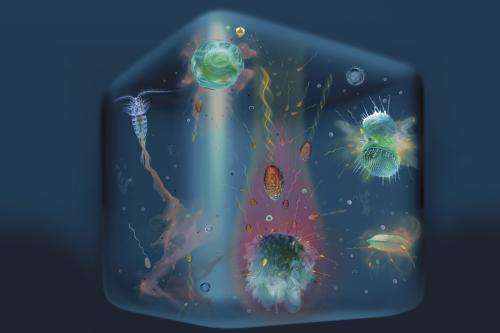Secrets from the deep

Violent bursts of organic matter from dying organisms, continuous showers of "marine snow" from the upper layers of a water column, and nutrients leaking from creatures so tiny they are invisible to the naked eye: this is the mysterious, microscopic world of our oceans.
One drop of seawater contains a world teeming with a million microbes that, when viewed under powerful microscopes, looks like a veritable feeding frenzy worthy of a Mad Hatter's tea party.
A major research project led by the University of Technology, Sydney (UTS) will use novel technologies to study this secret world, transforming the way we understand oceans.
The project will have a particular emphasis on the relationships between the ocean's microscopic plants and marine bacteria.
Building on work previously done in the laboratory, for the first time the experiments will be conducted in the ocean environment with natural populations of microbes.
This will deliver much more accurate insights than can be achieved using "microbial lab rats", says lead researcher from UTS, Dr Justin Seymour.
"Most people probably aren't aware that every drop of seawater contains about a million bacteria," says Dr Seymour, a Research Fellow in the Plant Functional Biology and Climate Change Cluster at UTS.
"They are mostly completely harmless to us and although they are invisible to us they play really important roles in how oceans function," he says.
"They form the base of the food web. All of the other organisms in the ocean derive their energy from these microbes and they control the ocean's chemical cycles," Dr Seymour says.
Microbes are the chemists of the ocean. They use, recycle, transform and release chemical compounds or chemical elements stored in organic matter.
"In turn," says Dr Seymour, "chemical transformation in the ocean ultimately influences the transfer of gases into the atmosphere. So, the way the microbes control the chemistry of the ocean ultimately influences the planet's climate."
The project is a collaboration that also includes Associate Professor Roman Stocker of the Massachusetts Institute of Technology (MIT) and Professor Phillip Hugenholtz and Dr Gene Tyson from the University of Queensland (UQ).
It recently received a $US3 million ($A3.2 million) grant from the Gordon and Betty Moore Foundation, one of the world's top 20 philanthropic organisations.
The foundation believes in bold ideas that create enduring impact in the areas of science, environmental conservation and patient care.
The co-founder of the world's largest semiconductor chipmaker Intel, Gordon Moore, and his wife Betty established the foundation to create positive change around the world.
In the field of science, the foundation looks for opportunities to transform or create entire fields of study by investing in early-stage research, emerging fields and top research scientists.
In contrast to traditional microbial ocean research that relies on taking samples from across kilometres of ocean and averaging the data, the project will examine the behaviour of microbes on a micro scale.
The project will deploy microfluidics – small chips the size of a credit card that allow for the precise control and manipulation of fluids on a tiny scale – to "trap" bacteria that respond to different chemical "bait" diffused from the chips into the seawater.
This will help explore how bacteria react to those organisms that release such chemicals.
The team will then apply genomics to the samples, which will ultimately allow them to decipher the chemical communications that influence microbial interactions in the sea.
"In the same way that a terrestrial ecologist would study the behaviour of lions and tigers across their territory, we are trying to do that from a microbial perspective, which means we have to zoom in on individual drops of water," says Dr Seymour.
"The same types of ecological processes that occur for big animals occur in this microscopic world. Microbes swim around and eat other microbes, and they forage for food and eat each other, just like animals do."
The research is expected to have far-reaching implications, giving other marine scientists a better understanding of how these tiny creatures behave and interact with other ocean life, how they regulate the chemistry of the ocean and, ultimately, how that affects the whole planet.
If it was possible to take a snapshot of the miniature world living inside a teaspoon of seawater, this is what it might look like.
Far from the old idea that ocean water was a static organic soup, we now know it is full of bustling activity.
It is a patchy, dynamic seascape of microbes racing for food being released from exploding organisms, plumes of dissolved organic matter created by marine snow particles, and hyperactive bacteria, propelled through the water by their whip-like flagella.
This image, created by Associate Professor Roman Stocker of the Massachusetts Institute of Technology (MIT), University of Technology, Sydney (UTS) marine microbiologist Dr Justin Seymour and UK artist Glynn Gorick, illustrates the microbial ocean world.
The researchers are part of a UTS-led team of experts who will spend the next three years deploying cutting-edge technology to explore this miniature marine world.
The trails and patches are the nutrients on which the bacteria feed. The excretions from the creature at the top left of the image (actually a zooplankton) are what could inelegantly be called plankton poo.
At the top left centre and bottom right, two phytoplankton cells have released dissolved organic matter creating a free food stall that attracts hungry bacteria.
More dramatically, on the top right, the death of a phytoplankton is captured in the moment of a violent burst of dissolved organic matter. And everywhere are bacteria, the oldest type of living organism on earth without which life could not exist.
Provided by University of Technology, Sydney




















